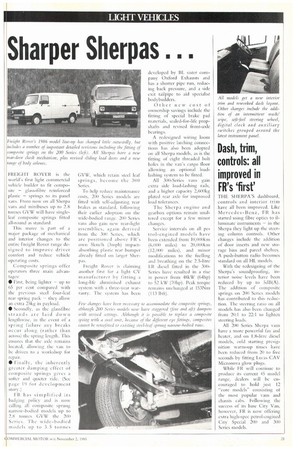Sharper Sherpas
Page 23

If you've noticed an error in this article please click here to report it so we can fix it.
Freight Roper's 1986 model line-up has changed little outwardly, but includes a number of important detailed revisions including the fitting of composite springs on the 200 Series (left). All Sherpas have a IleW rear-door check mechanism, plus revised sliding load doors and a new range of body colours.
FREIGI IT ROVER is the world's first light commercial vehicle builder to fit composite — glass-fibre reinforced plastic — springs to its panel VallS. From now on all Sherpa vans and minibuses up to 2.8 tonnes GVW will have singleleaf composite springs fitted all-round as standard.
This move is part of a major package of mechanical and interior changes to the entire Freight Rover range designed to improve driver comfort and reduce vehicle operating costs.
Composite springs offer operators three main advantages: • First, being lighter — up to 65 per cent compared with the previous steel four-leaf rear spring pack — they -allow an extra 25kg in payload.
• Secondly. as the glassfibre strands are laid down lengthwise. in the event of a spring failure any breaks occur along (rather than across) the spring length. This ensures that the axle remains located, allowing the van to be driven to a workshop to repair.
• Finally, the inherently greater damping effect of composite springs gives a softer and quieter ride. (See page 10 for development story.) FR has simplified its badging, policy and is now calling all composite sprung narrow-bodied models up to 2.8 tonnes GVW the 2(x) Series. The wide-bodied models tip to 3.5 tonnes GVW, which retain steel leaf springs. become the 30)) Series.
To help reduce maintenance costs, 200 Series models are fitted with self-adjusting rear brakes as standard, following their earlier adoption on the wide-bodied range. 200 Series vans also gain new rear-light assemblies, again derived from the 300 Series, which are positioned above FR's own 5kin/h (3mph) impactabsorbing plastic rear bumper already fitted on larger Sherpas.
Freight Rover is claiming another first for a light CV manufacturer by fitting a long-life aluminised exhaust system with a three-year warranty. The system has been
developed by BE sister company Oxford Exhausts and has a shorter pipe run, reducing back pressure, and a side exit tailpipe to aid specialist bodybuilders.
Other new cost of ownership savings include the fitting of special brake pad materials, scaled-for-life propshafts and revised front-axle. bearings.
A redesigned wiring loom with positive latching connec tions has also been adopted on all Sherpa models, as is the fitting of eight threaded bolt holes in the van's cargo floor allowing an optional loadlashing system to he fitted.
All 300-Series vans gain extra side load-lashing rails, and a higher capacity 2,600kg plated rear axle for improved load tolerances.
The Sherpa engine and gearbox options remain unaltered except for a few minor changes.
Service intervals on all petrol-engined models have been extended from 10,000km (6,0)0 miles) to 20,0()0krn (12,0110 miles). and minor modifications to the fuelling and breathing on the 2.5-litre I..R diesel fitted in the 3410 Series have resulted in a rise in power from 48kW (64hp) to 52 kW (70hp). Peak torque remains uncEniged at 153Nm (113 Ihft).












































































































